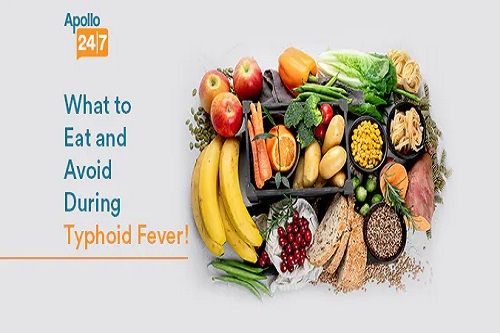General Health
Diet For Typhoid Patients: Food To Avoid During Typhoid
7 min read
By Apollo 24|7, Published on - 03 August 2022, Updated on - 07 November 2024
Share this article
0
1 like

Monsoon is often synonymous with a wide range of diseases such as cold, infections, allergies, fever, and so on with the chief among them being the “Typhoid Fever”. Typhoid fever is an intense form of infectious disease caused by consuming contaminated food and water that may be infected by ‘salmonella typhi bacteria’. Since the bacteria directly affects the digestive system and soon flows into the bloodstream, typhoid drains a patient’s body by inducing high fever, vomiting, loose motions, muscle pain, headache, and loss of appetite. While the antibiotic course is still the best treatment for typhoid, a good diet is extremely important to combat weakness and recover faster.
This article sums up the best diet plan for typhoid recovery along with some precautions to avoid further infection or relapse.
Also read: Is Your Monsoon Fever a Sign of Typhoid?
Avoid out-of-pocket healthcare expenses with Apollo 24|7's health insurance plan with premium as low as Rs.1 per day.
What to Eat During Typhoid Fever?
Dealing with typhoid fever can be challenging, and maintaining proper nutrition is crucial for a speedy recovery. Knowing what to eat in typhoid can help alleviate symptoms, boost your immune system, and ensure your body gets the essential nutrients it needs to fight the infection. Here’s some of the foods to incorporate into your diet plan for typhoid fever;
- Fruits
Fruits contain water, essential minerals and vitamins. This is why they are essential to combat dehydration and give a quick dose of energy. When considering what to eat in typhoid, fruits that are particularly beneficial are those that are rich in water content such as watermelon, sweet melon, grapes, apricots etc.
A bowl of ripe bananas, papayas, apples, guavas, sapodillas (chiku) and mangoes would do equally well. However, note that the number of fruits should not exceed one so that it is not heavy on the stomach and is easily digestible. Also, wash your fruits thoroughly and peel their skin to ease digestibility and cancel any risk of bad bacteria. - Soups
There is nothing like having a bowl of soup every day which is one of the best food for typhoid patient. Soups are nutrient-rich, easy to gulp and increase appetite in people who are experiencing no taste due to fever and malaise. One can consume chicken soup, mushroom soup, mixed vegetable soup and tomato soup. However, remember to avoid corn flour in soups until loose motions and stomach bloating subside. - Steamed Vegetables
Typhoid patients are recommended to avoid spicy and oily cooked vegetables. Instead, when considering ‘what to eat in typhoid’, have boiled vegetables such as potatoes, carrots, beans, beetroots, green peas, baby corn, bell peppers and onions. Remember not to toss them in oil, butter or ghee. Rather, add lemon juice, black pepper and salt for taste. Since these are both- easily digestible and equally nutritious, they’ll add to your quick recovery. - Proteins-rich Foods
Taking a protein rich diet for typhoid patients prevents weight loss and muscle loss during typhoid fever. Lentils, chicken, egg white, and cottage cheese, tofu, mushrooms can be taken in small quantities either in the form of soup ingredients or boiled form. However, if you experience nausea after consuming these proteins then discontinue having them for a week and speak with your doctor. - Low-fat Dairy Products
Low-fat dairy products such as buttermilk and curd are extremely beneficial during typhoid. Make sure to have them once a day to fulfil your calcium intake. Typhoid patients can also have a cup of low-fat milk with cornflakes for breakfast provided the milk is pasteurised to avoid the risk of other infections. If you are allergic to dairy or milk-based products, have a consultation with our dietitians and nutritionists, and get a customised typhoid diet chart. - Juices
Typhoid diet recommends staying hydrated especially because one has loose motions, vomiting and loss of appetite, so juice is one of the best food for typhoid patient . One needs to ensure they are hydrating themselves well to recoup from the infection and also flush out bacteria from the body. Coconut water, orange juice, mixed fruit juice, pomegranate juice, and watermelon juice along with 8 glasses of water daily helps in recovering faster.
However, it is advised to have either bottled water or boiled water during recovery to prevent the risk of re-infection. Also, make sure you are not drinking high sugar content juices as they could worsen diarrhoea. - ORS (Oral Rehydration Salt)
Since typhoid particularly disturbs the body’s digestive system and drains the body of its natural salts, hydrating the body and maintaining its salt balance becomes extremely important. The weakness felt due to fever, diarrhoea, and loss of appetite is best solved through a simple concoction of sugar, water, and salt, also known as ORS. The right balance of sugar and salt eventually helps you absorb the fluid better and balance the electrolyte deficit.
However, note that you use only boiled water for this concoction and clean your hands with soap and water regularly. Typhoid is contagious in nature and any carelessness with hygiene can multiply the infection’s severity not only in the patient but also risk the caregiver.
To know more details about the best food for typhoid patient based on overall health condition, consult with our general physicians and dietitians.
What Not To Eat During Typhoid?
We have seen what to eat in typhoid, now let’s have a look at what food to avoid during typhoid. Our doctors and nutritionists recommend a strict diet for typhoid patients. The patients are urged to avoid or limit the intake of the following foods. Here’s some of the food to avoid during typhoid:
- Dairy Products
Avoid having saturated fats such as ghee, oil, butter and spices as they can be tough on the digestive system and may cause additional discomfort. - Spicy and Junk Foods
Don’t include heavy meals, junk and spicy foods such as hot peppers, burgers, doughnuts, fried chicken, onion rings, french fries, canned meats, and potato chips to your diet plan for typhoid. These can get very heavy to digest and irritate the gastrointestinal tract thus risking heavy coughing. - Raw Vegetables
Raw vegetables like cauliflower, onions, cabbage, and broccoli are few of the food to avoid during typhoid. Instead, take nutrient-rich home-cooked meals every 2-3 hours along with plenty of fluids to compensate for fluid loss from the body. - High-Fiber Foods
Steer clear of high-fibre foods like raw vegetables, whole grains, and legumes, which can be hard to digest and may cause bloating and discomfort.
Also Read: Easy and Effective Tips To Prevent 7 Most Common Monsoon Diseases
Takeaway
While precaution is always better than cure, a typhoid infection may not always be preventable. Therefore, if you suspect any such contraction, begin with the typhoid diet plan immediately along with medicines prescribed by your doctor to help in quick recovery.
You are recommended to take fruits, boiled vegetables, soups, bottled water and low-fat dairy products to counter the infection. However, if you are having excessive nausea, or loss of appetite and cannot eat anything, do not hesitate to connect with our expert dieticians. They will ensure a customised typhoid diet chart which will help ease your discomfort.
Want a customised diet plan for typhoid?
General Health
Frequently Asked Questions
Can I eat chapati in typhoid?
Can I eat chapati in typhoid?
Can I have milk in typhoid fever?
Can I have milk in typhoid fever?
Can I breastfeed during typhoid?
Can I breastfeed during typhoid?
Can I drink alcohol with typhoid?
Can I drink alcohol with typhoid?
What to eat in typhoid?
What to eat in typhoid?
Leave Comment
Recommended for you

General Health
How Does Magnesium Benefit Your Health?
Discover magnesium health benefits for your overall health and learn how to incorporate it into your daily routine. Improve your well-being with this essential mineral!

General Health
What is Spinal Tuberculosis [TB]?
Read this blog post to know what is spinal tuberculosis. Spinal TB occurs when a bacterium called mycobacterium tuberculosis starts growing within the bones of the spinal column.

General Health
5 Healthy Drinks To Kick Start Your Mornings
Having a glass of refreshing drink every morning can improve your start to the day. Drinks such as methi water, cinnamon water, and jeera water are rich in nutrients that can boost your immunity and are essential in treating some common health problems.
Subscribe
Sign up for our free Health Library Daily Newsletter
Get doctor-approved health tips, news, and more.
Visual Stories

Plant-based Foods That Are a Great Source of Iron
Tap to continue exploring
Recommended for you

General Health
How Does Magnesium Benefit Your Health?
Discover magnesium health benefits for your overall health and learn how to incorporate it into your daily routine. Improve your well-being with this essential mineral!

General Health
What is Spinal Tuberculosis [TB]?
Read this blog post to know what is spinal tuberculosis. Spinal TB occurs when a bacterium called mycobacterium tuberculosis starts growing within the bones of the spinal column.

General Health
5 Healthy Drinks To Kick Start Your Mornings
Having a glass of refreshing drink every morning can improve your start to the day. Drinks such as methi water, cinnamon water, and jeera water are rich in nutrients that can boost your immunity and are essential in treating some common health problems.